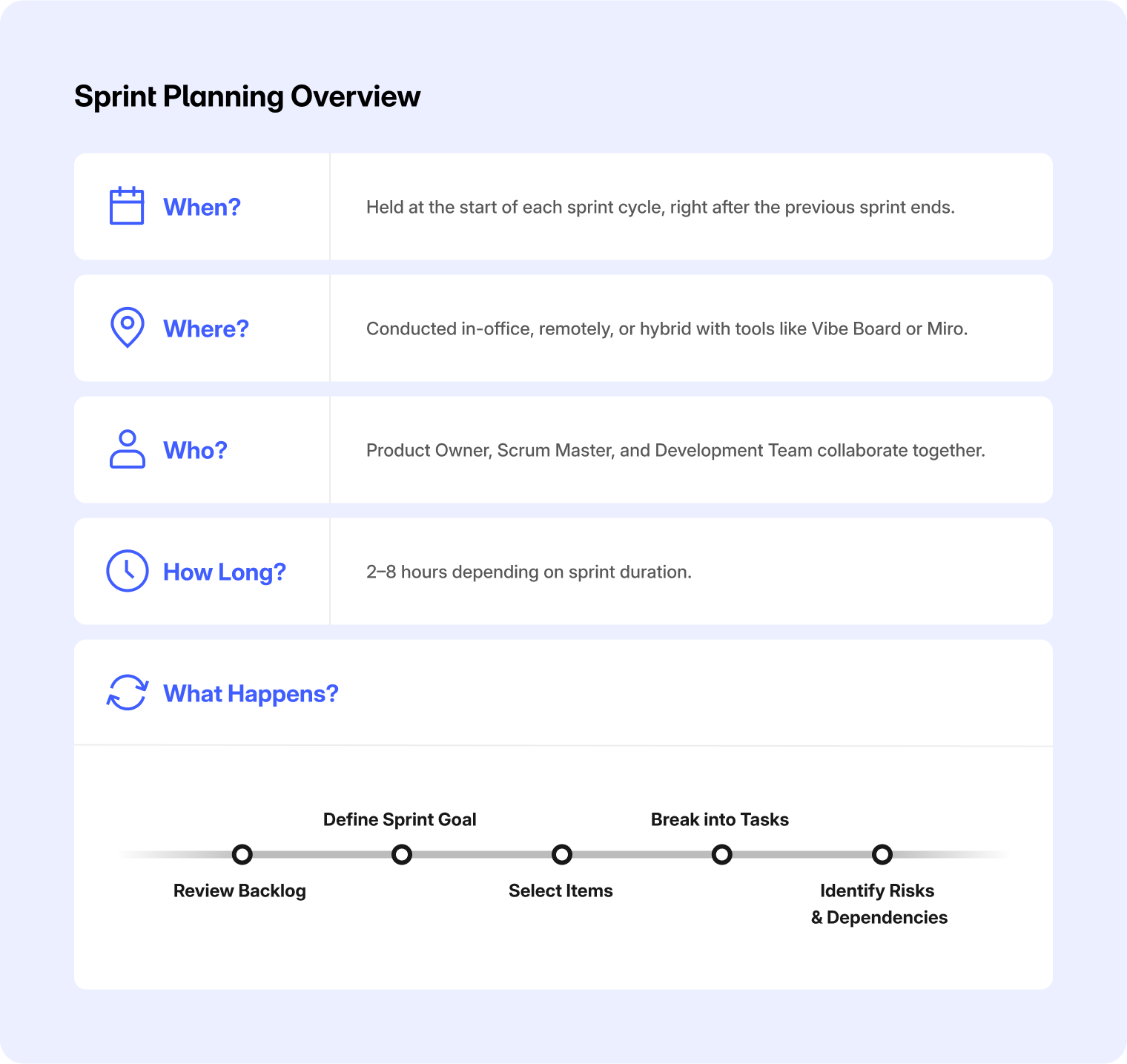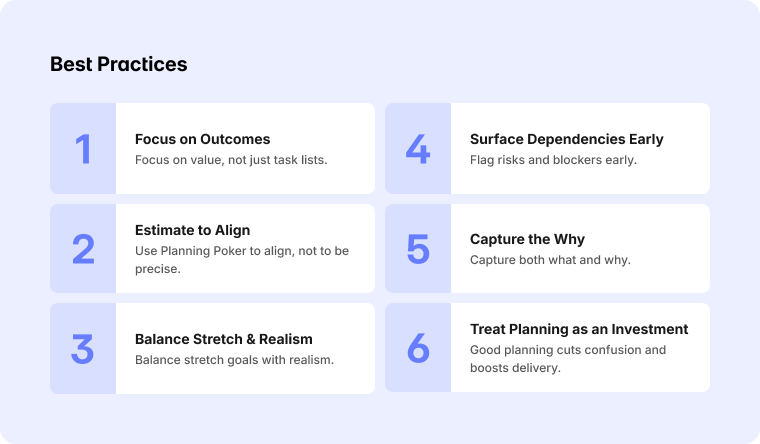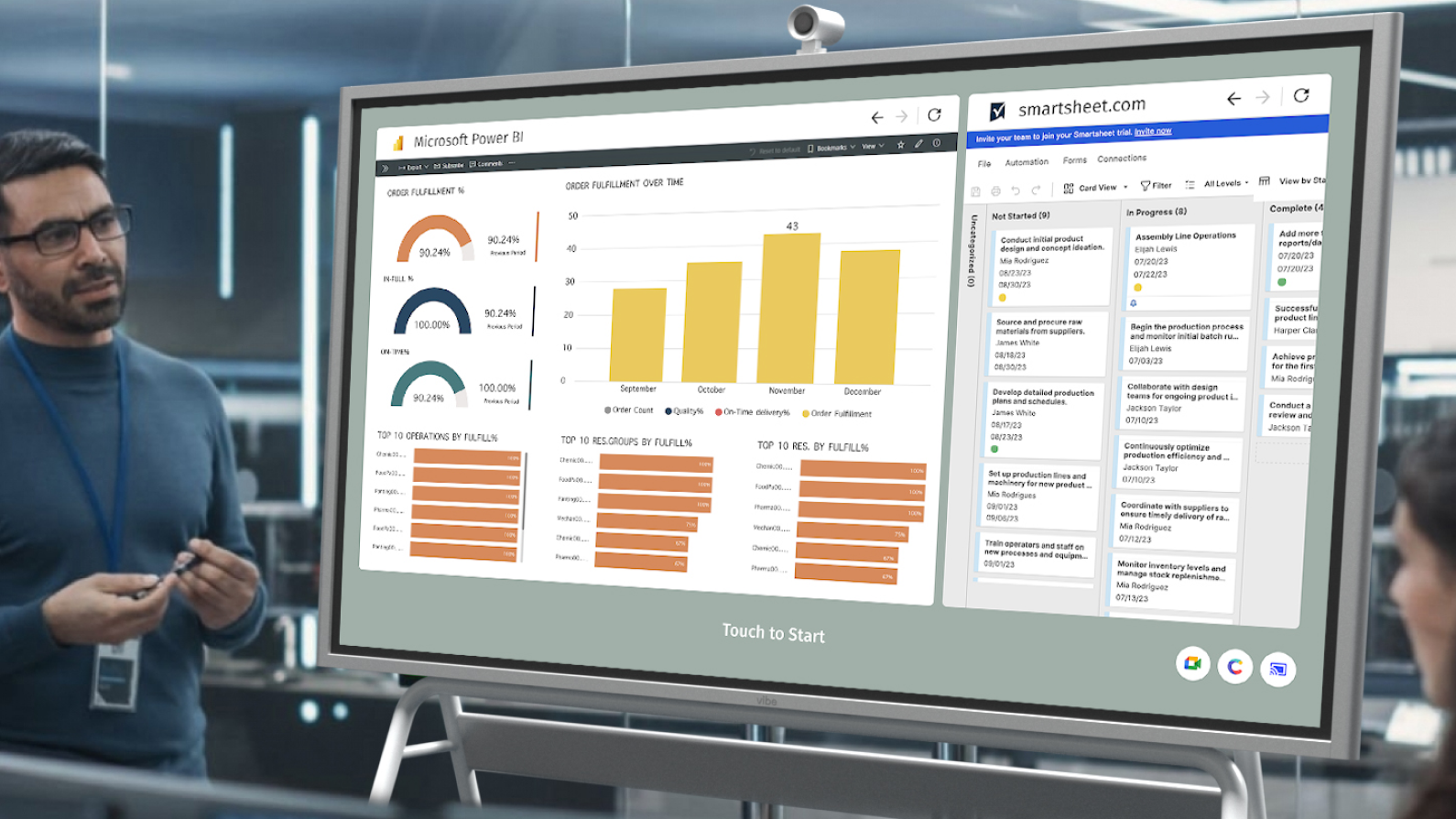Recently found yourself preparing to lead a room full of team members, struggling to turn a tangle of ideas into a clear sprint plan? You’re not alone. Sprint planning meetings can make or break an entire development cycle, yet many teams struggle to run them effectively.

Getting planning right is crucial for project success. When executed properly, these meetings catalyze abstract goals into actionable roadmaps, ensuring every team member understands their role and timeline. Poor sprint planning, however, leads to missed deadlines, poor team dynamics, confused priorities, and wasted resources that could have been avoided with proper structure.
This comprehensive guide will walk you through everything you need to know about running effective sprint planning meetings. You’ll learn the fundamentals of sprints and sprint planning, discover a proven 8-step process for structuring your meetings, and explore best practices that consistently drive results. By the end, you’ll have the tools and confidence to lead planning sessions that will set your team up for success.
- Sprint planning is a collaborative Scrum event where teams select backlog items, define sprint goals, and create actionable plans for the upcoming development cycle.
- Effective sprint planning meetings follow a structured 8-step process that balances preparation, goal-setting, stakeholder feedback, and realistic commitment-making within a timeboxed format.
- Success depends on six critical best practices: refined backlog preparation, clear goal definition, strict timeboxing, capacity-based planning, collaborative participation, and confident team commitments.
- Visual collaboration tools and interactive displays can transform traditional sprint planning into more engaging, productive sessions that improve team alignment and decision-making quality.
What is a Sprint?
A sprint is a fixed time period, typically 1-4 weeks, during which a Scrum team works to complete a set amount of work from the product backlog. Think of it as a focused work cycle where teams concentrate on delivering specific, potentially shippable product increments.
During each sprint, the development team maintains a steady rhythm of daily standups, focused development work, and continuous collaboration. This timeboxed approach creates urgency while providing enough structure to ensure quality deliverables. Understanding this foundation is essential because effective sprint planning sets the entire sprint rhythm in motion.
For your team, sprints transform chaotic project management into predictable, manageable workflows that consistently deliver value. This structured approach helps teams build momentum, maintain focus, and create a sustainable pace that prevents burnout while ensuring stakeholders see regular progress toward their goals.
What is Sprint Planning?
Sprint planning is the collaborative Scrum event where development teams examine the product backlog, identify key items for the upcoming sprint, create clear sprint goals, and determine how the selected work will be accomplished. It serves as the starting foundation that transforms product vision into executable development tasks.

This crucial meeting aims to address five fundamental aspects that determine sprint success:
When Does It Occur?
Sprint planning takes place at the beginning of each sprint cycle, immediately after the previous sprint concludes. Most teams schedule these meetings on the same day each cycle to establish predictable rhythms. The timing ensures fresh perspective from recently completed work while maintaining forward momentum toward upcoming deliverables.
Where Is It Held?
Modern sprint planning occurs in various settings depending on team structure and preferences. On-site teams often gather together in meeting rooms equipped with whiteboards, post-its, or smart whiteboards for conference rooms that facilitate visual collaboration. Remote teams leverage digital collaboration tools like Miro, Trello, or Vibe, while hybrid teams blend both approaches for maximum flexibility and engagement.
Who Attends?
Sprint planning requires participation from the entire Scrum team, including the Product Owner, Scrum Master, and all Development Team members. The Product Owner brings backlog priorities and business context, while the Scrum Master facilitates the process and keeps things on track. Development team members contribute technical expertise, estimate effort, and build the plan.
Learn more about the basics of Scrum meetings and roles →
How Long Do They Last?
Sprint planning meetings are timeboxed based on sprint duration to maintain focus and efficiency. One-week sprints typically require 2 hours of planning time, while two-week sprints need approximately 3-4 hours, and four-plus-week sprints may take up to 8 hours. These time limits prevent analysis paralysis while ensuring thorough consideration of all necessary planning elements.
What Happens?
During sprint planning, teams review the product backlog, select items that align with sprint capacity, define specific sprint goals, and break down selected work into manageable tasks. The meeting balances strategic thinking with tactical planning, ensuring both business objectives and technical feasibility receive appropriate attention. Teams also identify potential risks, dependencies, and resource requirements that could impact sprint success.
How to Run a Sprint Meeting in 8 Steps
Following these structured steps will help you organize effective sprint planning meetings that stay focused, finish on time, and consistently produce actionable results. Each step builds upon the previous one, creating an easily followable flow that maximizes team engagement and planning quality.
Step 1: Pre-Meeting Preparation
Successful sprint planning begins well before the meeting starts, with thorough preparation of all necessary materials and information. Ensure the product backlog is refined, prioritized, and contains detailed user stories with clear acceptance criteria. Prepare meeting logistics, including room setup, technology requirements, and stakeholder invitations to avoid delays or confusion during the actual planning session.
Step 2: Welcome and Introduction (5-10 minutes)
Begin each sprint planning meeting with brief introductions and agenda review to set expectations and focus. Welcome all participants, especially any new team members or stakeholders who may be joining for the first time. Quickly outline the meeting structure, time allocations, and desired outcomes to ensure everyone understands their role in the collaborative planning process.
Step 3: Review Sprint Goals and Context (10-15 minutes)
Establish clear context by reviewing the previous sprint’s outcomes, current product roadmap position, and broader business objectives. Present the proposed sprint goal that aligns with product strategy and stakeholder expectations. This context helps team members understand how their individual contributions connect to larger organizational goals and customer value delivery.
Step 4: Demonstrate Completed Work (15-25 minutes)
Showcase work completed during the previous sprint to provide feedback and build momentum for upcoming planning decisions. Focus on demonstrating working features, addressing any incomplete items, and discussing lessons learned from recent development cycles. This review helps team members understand the current product state and identify potential dependencies or opportunities for the next sprint.
Step 5: Gather Stakeholder Feedback (10-15 minutes)
Collect input from stakeholders regarding demonstrated work, upcoming priorities, and any changes in business requirements or market conditions. Encourage open dialogue about feature performance, user feedback, and strategic direction shifts that might impact sprint planning decisions. Document all feedback for consideration during backlog prioritization and future planning cycles.
Step 6: Review and Prioritize the Backlog (10-15 minutes)
Examine the current product backlog with stakeholder feedback in mind, adjusting priorities and adding new items as necessary. Collaborate with the Product Owner to ensure backlog items remain relevant, properly prioritized, and aligned with current business needs. This review ensures sprint planning decisions reflect the most current understanding of product requirements and customer needs.

Step 7: Surface Risks and Challenges (5-10 minutes)
Address any obstacles, technical challenges, or resource constraints that could impact sprint success. Encourage team members to voice any concerns about capacity, dependencies, or potential roadblocks early in the planning process. Identify specific actions needed to resolve impediments and assign responsibility for follow-up to ensure issues don’t derail sprint progress.
Step 8: Confirm Next Steps and Wrap Up (5-10 minutes)
Conclude the meeting by confirming collective and individual sprint commitments, documenting collaborative decisions, and scheduling any necessary follow-up discussions. Review the finalized sprint backlog, sprint goal, and timeline to ensure team alignment and understanding. Establish clear next steps, including daily standup schedules, milestone check-ins, and the date for the next sprint planning session.
This structured approach guides effective, comprehensive planning while respecting time constraints and maintaining team engagement throughout the entire process.
Sprint Planning Best Practices
Following these essential best practices will significantly improve your sprint planning effectiveness and team satisfaction:

-
Focus on outcomes over outputs – Prioritize sprint goals that deliver customer value and business impact rather than simply completing a list of tasks, ensuring every selected backlog item contributes meaningfully to broader product objectives.
-
Embrace estimation as team alignment, not precision – Use collaborative estimation techniques like Planning Poker to build shared understanding of complexity and effort rather than seeking perfect accuracy, fostering collective ownership of sprint commitments.
-
Balance ambition with realism – Challenge your team to stretch their capabilities while maintaining a sustainable pace, using historical velocity as a guide but not a rigid constraint for continuous improvement.
-
Make dependencies visible early – Identify and discuss external dependencies, technical risks, and cross-team coordination needs during planning to prevent surprises that could derail sprint progress.
-
Document decisions and rationale – Capture not just what was committed but why specific choices were made, creating valuable context for future sprint planning sessions and retrospective discussions.
-
Treat sprint planning as an investment in team performance – View the time spent in thorough sprint planning as an investment that pays dividends through reduced mid-sprint confusion, fewer scope changes, and higher quality deliverables.
 Team using a Vibe Board in a sprint meeting to display real-time project progress and align on current sprint goals.
Team using a Vibe Board in a sprint meeting to display real-time project progress and align on current sprint goals.
Vibe Board S1: Create and Visualize Your Sprint Goals Like Never Before
Traditional sprint planning often relies on static documents and disconnected tools that limit collaboration and visual thinking. The Vibe Board S1 reimagines these sessions into dynamic, interactive experiences where teams can visualize backlog items, map dependencies, and collaborate in real-time on a responsive 55-inch touch display.
With easy integration to over 250 commonly used sprint apps, including Jira, Monday.com, Slack, and more, the Vibe Board becomes your central project management board where collaborative planning flows naturally into execution tracking. Teams can leverage collaborative estimation techniques, create visual sprint roadmaps, and maintain engagement through interactive brainstorming. Whether your team works remotely, in-office, or hybrid, the cloud-based infinite canvas ensures everyone can contribute meaningfully to planning regardless of location.
Ready to revolutionize your sprint planning meetings and build incredible products through better collaboration? Book a demo today to see how the Vibe Board S1 can transform your Agile workflows and drive better sprint outcomes.
 Team conducting an Agile sprint planning session on the Vibe Board, visualizing tasks and collaborating in real time.
Team conducting an Agile sprint planning session on the Vibe Board, visualizing tasks and collaborating in real time.Sprint Planning FAQs
What are the 5 stages of sprint planning?
The five stages of sprint planning include: preparation (backlog refinement and logistics), goal setting (defining sprint objectives), backlog selection (choosing items for the sprint), task breakdown (decomposing selected items into actionable tasks), and commitment (finalizing what the team will deliver). These stages ensure comprehensive planning while maintaining focus on deliverable outcomes.
What is the 3:5:3 rule in Scrum?
The 3:5:3 rule is a guideline for sprint retrospectives, not sprint planning, where teams spend 3 minutes setting the stage, 5 minutes gathering data about what happened during the sprint, and 3 minutes deciding what to do differently in the next sprint. This timeboxing approach keeps retrospectives focused and actionable.
What is an example of sprint planning?
A typical sprint planning example involves a development team reviewing their product backlog containing user stories like "As a customer, I want to reset my password via email." The team estimates this story at 5 story points, discusses implementation approaches, identifies dependencies on the email service, and commits to completing it along with other selected items within their 2-week sprint capacity. The session concludes with a clear sprint goal: "Enable customer self-service password management" and documented commitments for all team members.









-1sbltxxq4FYxHrXrwJVLsCDNsXpqNa.webp)
-5Zp0pmSytvcuYDVs1LvuwplKuRneK0.webp)
